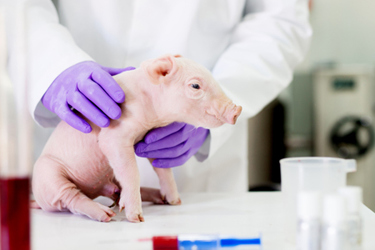Miniature Swine In Nonclinical Studies

Leveraging extensive experience with various research lineages of miniature swine, explore our therapeutic and research areas, as well as our applications of the miniature swine model and more.
The miniature swine continues to develop as a viable non-rodent option for nonclinical studies. With the increase of historical data and wider regulatory acceptance, the miniature swine model can support a variety of research areas. Their availability, physiological similarities to humans, and lower cost compared to other non-rodent models makes miniature pigs an advantageous option for nonclinical programs. However, it is essential that scientific rationale is the driving factor when selecting species for your study.
At Altasciences, we are experienced with multiple research lineages of miniature swine, including the Hanford™, Göttingen™, Sinclair™, and Yucatan™. The Sinclair Nanopig™ is the smallest of the produced breeds, and has been further downsized, which can decrease your test article usage.
Applications of the Miniature Swine Model
Altasciences has developed strong expertise in a number of therapeutic areas for the miniature swine, including dermal, metabolic diseases, inflammation, oncology, CNS disorders, ocular diseases, and HIV. Our team of talented veterinary surgeons and experienced pharmacology and toxicology scientists combine their skills in a variety of modalities, molecules, and disease indications, to support in vivo studies that progress the development of your novel drug candidate.
Watch a webinar that explains the miniature swine model selection criteria for toxicology and pharmacology studies.
Consult our preclinical drug development factsheet for more information on the full range of in vivo non-GLP and GLP preclinical evaluation studies at Altasciences.
Our Miniature Swine Expertise
Our preclinical facility in Columbia, Missouri, has one of the largest miniature swine populations in the United States. With 80 custom-designed animal rooms and experience with both small and large molecules, our team can get your study started in six to eight weeks following contract signing. The Columbia site also offers IND- and NDA-enabling toxicology, and safety pharmacology services.
Dosing routes available for miniature swine:
- aural
- dermal (topical)
- intra-articular
- intra-bladder (females only)
- intramuscular
- IV bolus
- IV infusion
- oral (gavage and capsule)
- subcutaneous–injection or surgical implant
- targeted GI sections for infusions/repeat bolus dosing
